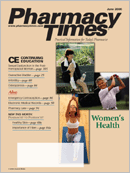Osteoporosis in Postmenopausal Women
Osteoporosis is a bone disorderin which bone mass in thebody decreases, thus causingbones to become weakened to theextent that minimal trauma may causefractures.1 It is believed that calcium andestrogen are major factors in the buildingand maintaining of bone strength inwomen.2 Studies show that postmenopausalwomen have a higher frequencyof osteoporosis due to the rapid loss ofcalcium from the bones and the lowerlevels of estrogen in the blood.2
Prevalence
According to the American MedicalWomen's Association, osteoporosis is acommon disease state affecting approximately29 million people in theUnited States.3 In women, it is believedthat bone mass declines gradually afterage 30 and that this decrease progressesmarkedly at menopause. In fact, it isestimated that 13% to 18% of women inthe United States who are at least 50years old have osteoporosis, and anadditional 37% to 50% have osteopenia,which is the presence of less than thenormal amount of bone mass.4,5 This isan important finding, because osteoporosiscauses 1 million fractures yearly,and the mortality rate following a hipfracture is 12% to 20%.3 For postmenopausalwomen, hip fracture is thesecond leading cause of admission tonursing homes and is one of the majordisorders that contribute to the loss ofindependence and quality of life.3
Risk Factors
Risk factors for osteoporosis include afamily history of osteoporosis or fracturein a first-degree relative, low body weight,a history of bone fracture as an adult, currentcigarette smoking, Caucasian race,poor nutrition, alcoholism, early menopause,long-term low calcium intake, andinadequate physical activity.3
Diagnosis
Women who are postmenopausaland at least 65 years of age, womenwho are younger than 65 years of agebut have at least one risk factor forosteoporosis, and women who are postmenopausalwith fractures should makean appointment to visit their primarycare provider to see whether they sufferfrom osteoporosis.4
Pharmacologic Treatment
Osteoporosis may be prevented andtreated with several medications. Themost common medications include calciumand vitamin D, bisphosphonates,selective estrogen receptor modulators(SERMs), calcitonin-salmon, teriparatide,and hormone replacement therapy.
Calcium and Vitamin D
Calcium intake can prevent and/orreduce bone loss in adults. There are differentcalcium salts, such as carbonate,citrate, and lactate. Calcium carbonateshould be ingested with food toincrease calcium absorption.6 Calciumcitrate is easily absorbed, has few sideeffects, and does not need to be takenwith food.6 Patients should take 500 to600 mg of calcium carbonate or 200 to315 mg of calcium citrate per day.Vitamin D should be taken at a dose of400 international units per day toensure optimal calcium absorption.6Different combinations of calcium andvitamin D are available.
Bisphosphonates
This class includes such medicationsas alendronate (Fosamax), risedronate(Actonel), and ibandronate (Boniva). Theyare used to prevent and/or treat osteoporosis.Bisphosphonates increase bonedensity by reducing bone loss mainly atthe spine and hip.
Side effects include upset stomachand headache. Bisphosphonates maybe taken daily, weekly, or monthly. Toavoid developing long-term stomachirritation, it is very important for thepatient to take these medications with6 to 8 oz of plain water on getting up inthe morning, and more than 30 minutesbefore ingesting the first food,beverage, or other medication. Aftertaking this medication, the patientshould stay in an upright position (notlying down) for at least 30 minutes. Italso is necessary to have adequate calciumand vitamin D intake while takinga bisphosphonate.6
SERMs
Raloxifene (Evista) is the only FDA-approveddrug from the SERM class.SERMs work as a natural hormone onestrogen receptors on bones to decreasebone loss. This class of medications doesnot affect breast and uterine tissue, thuseliminating several side effects. In onestudy, raloxifene increased bone mineraldensity in the spine and femoral neck andreduced risk of vertebral fractures.7 Sideeffects, however,may include hot flashes,joint pain, and possible risk for deep veinthrombosis.6 A SERM is a good alternativefor women who cannot tolerate estrogen.
Calcitonin-salmon (Miacalcin)
Calcitonin-salmon blocks the effect ofnatural calcitonin in the body and preventsbone loss. It is used for osteoporosistreatment for women at least 5years postmenopausal.6 It is less effectivethan other osteoporosis medications.Thus, it is used more frequentlyfor patients with fracture pain or forpatients who cannot use other osteoporosismedications for different reasons.It has been shown to reduce therisk of spinal fractures.
Teriparatide (Forteo)
Teriparatide is a parathyroid hormoneanalogue. It is used once daily to stimulatethe building of bone mass byincreasing calcium absorption in thegut. Treatment with teriparatide willincrease bone mineral density, bonemass, and bone strength.
Hormonal Therapy (HT)
Estrogen replacement therapy increasesbone density. HT relievesmenopausal symptoms such as hotflashes, vaginal dryness, and nightsweats. Some studies indicate that HTcan increase bone density by 5% in 2years.8 The use of HT is approved for theprevention but not for the treatment ofosteoporosis. The decision to use HTshould be based on the patient's riskfactors, because this therapy has severalunwanted side effects. It also shouldbe remembered that bone loss willresume once HT is stopped.
Nonpharmacologic Treatment
Women, especially postmenopausalwomen, can prevent or reduce their riskof developing osteoporosis by takingcalcium daily and exercising appropriately.Appropriate exercise includes atleast half an hour of weight-bearingexercise, such as jogging, walking, stairclimbing, dancing, tennis, or weight lifting.It is recommended that these exerciseactivities be done at least twiceweekly and for 40 minutes each time.Avoiding cigarette smoking and alcoholintake will help reduce risk.6 Studiesalso show that 15 to 20 minutes of sunlightexposure daily will help maximizethe absorption of calcium.
Summary
Osteoporosis is common among postmenopausalwomen. Taking appropriatemeasures to avoid risk factors such ascigarette smoking and alcohol intake maybe helpful. Medications such as calcium,vitamin D, bisphosphonates, SERMs, calcitonin-salmon, teriparatide, and hormonereplacement therapy have been shownto be beneficial. Patients should beadvised to check with their doctor beforetaking any medication.
Dr. Leyzerenok received her PharmDdegree from the Arnold & MarieSchwartz College of Pharmacy andHealth Sciences, Long IslandUniversity, in May 2006. Dr. Pham isan assistant professor of pharmacypractice at that institution. At the timethe article was written, Dr. Pham wasMs. Leyzerenok's preceptor for internalmedicine clinical rotations.
For a list of references, send astamped, self-addressed envelope to:References Department, Attn. A. Stahl,Pharmacy Times, 241 Forsgate Drive,Jamesburg, NJ 08831; or send an e-mailrequest to: astahl@ascendmedia.com.

